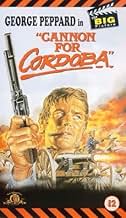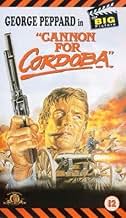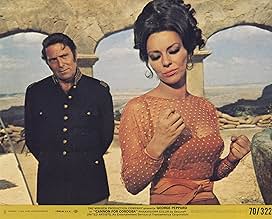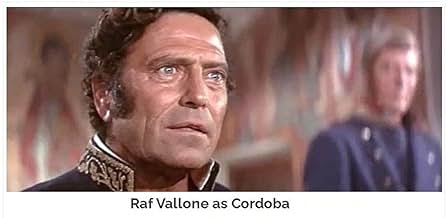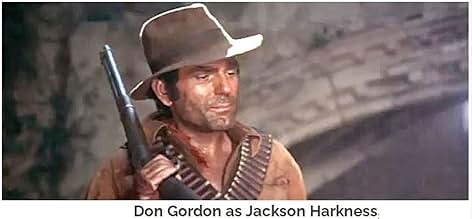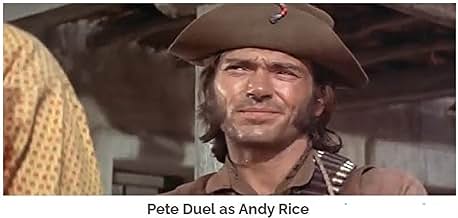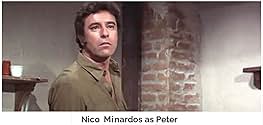Ajouter une intrigue dans votre langueIn 1916, when a Mexican rebel steals cannons from the American army, General Pershing sends out a group of misfits to retrieve the stolen weapons.In 1916, when a Mexican rebel steals cannons from the American army, General Pershing sends out a group of misfits to retrieve the stolen weapons.In 1916, when a Mexican rebel steals cannons from the American army, General Pershing sends out a group of misfits to retrieve the stolen weapons.
Charles Stalnaker
- Capt. Riggs
- (as John Stalnaker)
Avis en vedette
Cannon for Cordoba (why not Cannons, Cordoba steals six!?) stars George Peppard (The A-Team, The Blue Max!) and is one of those movies playing in the times of Mexico's long phase of revolutions and counter-revolutions starting around 1910 and going on for some decades. The pros of the movie: good acting, some good action, good production. The cons: nothing really new if you already watched such classics like Kazan's Viva Zapata! (1952, Marlon Brando), Peckinpah's The Wild Bunch (1969) or Leone's Giù la testa (Duck, You Sucker!) among others, all playing in the same time frame. Compared Cannon for Cordoba can hold its ground but can't really add something new - solid.
It is a western set in Mexico, a pretext for an explosive farce. It is based on an excellent script, curiously signed by Stephen Kandel, prolific screenwriter for television. Here we have a film influenced by the spaghetti western, supported by a heterogeneous cast that is one of the flavors of the film, or rather heterogeneous and sympathetic, with actors with recognizable faces that we have inevitably seen elsewhere. And as for the female cast, it is also a success. The two female characters, even if not very present on the screen, are notable and striking. Both for the plastic poses (especially for Francine York), important in this world of dust and dirt, and critical for the dramatic progression for the second, Giovanna Ralli.
On the direction, Paul Wendkos, who is also a product of television (many series to his credit, including contributions to The Untouchables or The Invaders). Here he has a lot of fun with some crazy camera angles and zooms, which date the film a little, but which are not detrimental to the progression.
The richness of the script is in the relationship between the people of George Peppard's gang. Each of them is characterized simply and well embodied by each of the actors: they each present a real personality; their scenes between them are the most interesting. The least interesting of the lot is George Peppard himself, who goes through the film in a mechanical way. It is as if he is not concerned by the film.
The film adds to the spectacular, the explosions and the violence (in the spaghetti sense of the term). All in all, it becomes a curious product that maintains interest over time despite its flaws (stereotypes, rough direction of the actors).
On the direction, Paul Wendkos, who is also a product of television (many series to his credit, including contributions to The Untouchables or The Invaders). Here he has a lot of fun with some crazy camera angles and zooms, which date the film a little, but which are not detrimental to the progression.
The richness of the script is in the relationship between the people of George Peppard's gang. Each of them is characterized simply and well embodied by each of the actors: they each present a real personality; their scenes between them are the most interesting. The least interesting of the lot is George Peppard himself, who goes through the film in a mechanical way. It is as if he is not concerned by the film.
The film adds to the spectacular, the explosions and the violence (in the spaghetti sense of the term). All in all, it becomes a curious product that maintains interest over time despite its flaws (stereotypes, rough direction of the actors).
Tipical golden-age western plot, a bunch of reluctant heroes in a suicide mission against the bad guy (and, as usually, his army of well armed companions). The main problem with this movie, like many other American commercial movies, especially westerns, is originality. Elmer Bernstein score is like one hundred other westerns music scores, the main character, George "Breakfast at Tiffany's" Peppard as the captain Douglas, is very much annoyed all the time; Giovanna Ralli and Raf Vallone apparently in paid holiday and the director Paul Vendkos (poor guy!) has made the capital mistake, I really think he has seen "The Professionals" by Richard Brooks (1966), that is the better version of the same story (by the way, is a masterpiece). The most notable thing of this unfortunate movie is George Peppard's cigar that you can see in "The A-Team" television series all through the eighties.
Once you sit down to see this film " A Cannon for Cordoba " you get the feeling it's going to be a great. The reason? The film begins with a rousing score by noted composer Elmer Bernstein who gave us such memorable themes as 'The Great Escape and the Magnificent Seven.' Indeed, when you read the opening credits headlining the cast is none other than George Peppard as Capt. Rod Douglas, you know it's going to have action and lot's of it. Furthermore when you see actor John Russel playing General John J. Pershing, you know you're in for a heroic saga. The story is taken from the annals of the Mexican revolution and involves the U.S. in a border town dispute with the Mexican bandits who cross the Rio Grande in the early 1900s. Among the most brazen of the rebel leaders is General Cordova (Raf Vallone). With his army of Mexican revolutionaries, he attacks Pershing, kills his men and steals some valuable artillery pieces. Since the United States Army cannot enter Mexico legally, Capt. Douglas is sent on what is slated a suicide mission, without orders and without aid from Pershing. His mission is to retrieve the Cannons, destroy a rebel stronghold and bring Cordova back alive. Selecting the roughest, toughest, most experienced, certainly the most insolent men available, Douglas enters Mexico and attacks the nearly impregnable fortress. Dramatic action follows, as does lots of explosive excitement. If one is asks for criticism, I would say the choice of heavies. Vallone and John Larch are not very menacing. Not so with the men who side with Peppard. Pete Duel and Don Gordon (Who is superb.) Nevertheless, this movie is recommended as good viewing. ****
I have reasons to love the great users of a camera; fluid direction of action lends itself to fast-paced adventure and comedy narrative; but such a skill, in the hands of a King Vidor or an Anthony Mann can also be applied to idea-level work. This is Paul Wendkos' masterpiece. Its storyline can be retailed in a single pair of sentences. General Hector Cordoba is setting up as near-emperor in Northern Mexico, and steals a huge cannon from General Blackjack Pershing. he sends his crack mission unit, divided, apprehensive but determined, led by George Peppard, to get the cannon back and bring back Cordoba alive, to put an end to the rebellion. Charismatic Raf Vallone plays Cordoba; the ladies in the piece are Giovanna Ralli and Francine York; with the squad even further comprised of Nico Minardos, Peter Deuel, and Don Gordon. Other stalwarts in the class include John Larch and John Russell. Also horning in on an already fantastically-dangerous operation are Miss Ralli, and a stubborn Mexican Teniente (Gabriela Tinti) whose regiment was betrayed when Cordoba set up on his own. The danger is multiplied when Gordon's brother as advance spy is captured and tortured to death while he has to watch...and he decides he needs to kill Peppard. The attack that captures the cannon, when Peppard's orders are not obeyed by a regular army type, is one of the most electrifying visual and staging achievements in cinematic history; the penetration of Cordoba's stronghold, the revelations uncovered there, and the actions that win the mission team a chance at victory--or almost victory--are flawlessly presented. This is a beautiful color adventure film, with unusually strong costumes, acting, lighting, art direction sets and music by Elmer Bernstein. The script by Stephen Kandel is probably his best ever for a feature film. This is probably the most underrated major western at the moment, but I have always appreciated its heroes as result- getting hard-workers. But as Peppard reminds his group on the way home, "The trouble with being a "hero"--is the morning after". To find out why he says so, you will have to see "Cannon For Cordoba".
Le saviez-vous
- AnecdotesFrancine York told an interviewer that she had no problem being topless in the movie. She said when she was offered the role, she thought, "I have beautiful breasts, so why not?".
- GaffesThe uniform stolen from a much shorter and stouter soldier fits Antonio perfectly.
- Citations
Capt. Rod Douglas: The trouble being a hero is the morning after.
- ConnexionsReferenced in Guns for Hire: The Making of 'The Magnificent Seven' (2000)
Meilleurs choix
Connectez-vous pour évaluer et surveiller les recommandations personnalisées
- How long is Cannon for Cordoba?Propulsé par Alexa
Détails
- Durée1 heure 44 minutes
- Couleur
- Rapport de forme
- 2.35 : 1
Contribuer à cette page
Suggérer une modification ou ajouter du contenu manquant

Lacune principale
By what name was Cannon for Cordoba (1970) officially released in India in English?
Répondre
